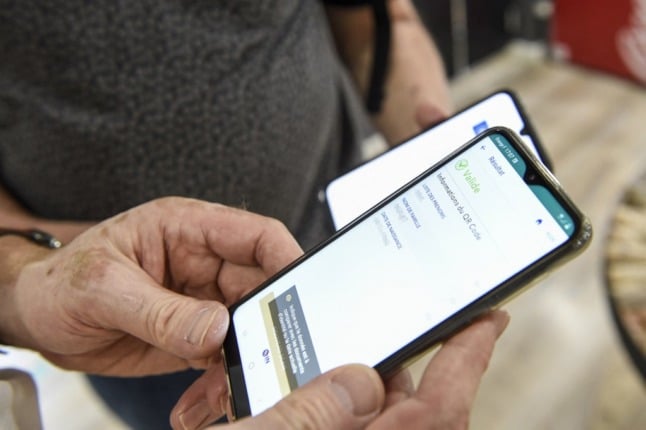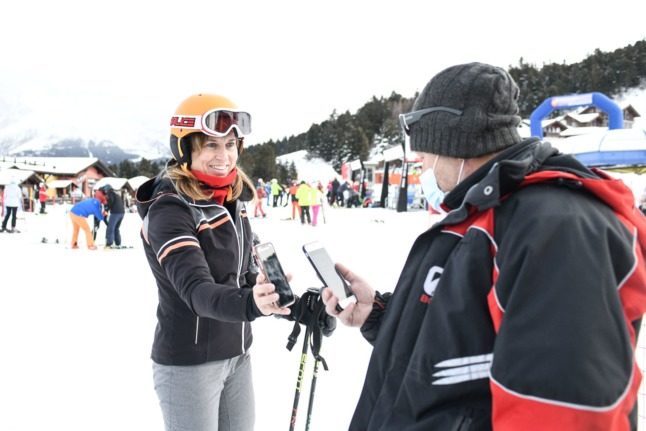Italy’s ski resorts began opening for the new season in late October with a strict health protocol in place.
After two winter seasons hit hard by the Covid crisis, Italy faced the same challenge as its Alpine neighbours of France, Switzerland and Austria – figuring out how to get the ski industry back on its feet safely amid a new wave of infections across Europe.
READ ALSO: What will Italy’s Covid restrictions be this Christmas?
Italy’s ski industry hoped that Covid-19 health passes, masks and other health measures would be enough to prevent closures this year; and so far, they’ve been right.
Despite the country’s infection rate soaring in recent weeks, the Italian government has been determined to keep the country open as far as possible.
It’s achieved this by allowing the vaccinated and Covid-recovered to continue to access all venues and services nationwide, while increasingly tightening restrictions on the unvaccinated.
New rules that come into force on January 10th prevent those who are unvaccinated or not recently recovered from Covid from accessing ski resorts.
Here’s a closer look at the measures in place going forward for the 2021/22 season, with the obvious caveat that things can change at short notice.
‘Green pass’ requirement
From January 10th, a ‘super green pass’ health certificate, reserved for those who are vaccinated against or recovered from Covid, is required to access all ski slopes across the country for anyone aged 12 and up.
Previously a basic ‘green pass’, which can also be obtained via a negative Covid test result, was all that was needed to go skiiing in Italy’s least-restricted ‘white’ or ‘yellow’ risk category regions, while a ‘super green pass’ was required only in more restricted ‘orange’ zones (as of January 10th, the entire country is either a ‘white’ or ‘yellow’ zone).
That changed with a decree that came into force on December 30th as the government introduced new measures aimed at keeping Italy’s contagion curve under control. The reinforced or ‘super’ green pass is now required to access most leisure facilities and venues; ski lifts and slopes among them.
EXPLAINED: Where do you now need to show a Covid green pass in Italy?
A green pass check will be carried out at the same time as ski passes are validated, with most resorts now using apps which merge their ski pass with the Italian green pass, such as the Dolomites Superski app.
“If the green pass is valid, the ski pass is activated for that day. Those who have a multi-day or seasonal ski pass will activate it via the app before the start of each ski day”, explained the president of the association of South Tyrolean cable car operators, Helmut Sartori.
Some resorts such as Cervinia have made it mandatory for visitors to purchase ski passes online as part of efforts to keep crowds under control.
At bars and restaurants, from January 10th the ‘super’ green pass is also requirement for all customers aged over 12 under nationwide rules for both indoor and outdoor dining.
Hotels, which could formerly be access via a basic green pass, also require a super green pass from this date. Read more about the current Italian health pass requirements here.
What other rules are in place?
Surgical-grade or FFP2 masks are mandatory both on ski slopes and in any public areas (including outdoors) in resorts where queues or crowds are likely.
Capacity is reduced to 80 percent for closed cable cars, while open chairlifts can operate at full capacity.
Ski slopes must use lanes which “guarantee interpersonal distancing of at least one metre” and staff should be on hand to enforce rules and check for areas at risk of overcrowding.
The standard Italian rules on masks and distancing will also be in place at all businesses.

Will these rules be in place throughout the winter?
Ski operators are keen to avoid a repeat of last year, when photos and videos were widely shared online showing maskless crowds at resorts – despite the strict health measures in place nationwide.
Ski slopes remained closed for most of last winter under tight restrictions, only opening in late February 2021 after infection rates began to fall.
There is no guarantee that the rules won’t change again this winter, and it all depends on the health situation in Italy overall, as well as in specific regions.
Business closures are unlikely unless any region is declared a high-risk ‘red’ zone.
Under red zone restrictions, ski lifts, restaurants, bars and other facilities would be closed.
What about travel to Italy?
All travellers entering Italy from a ‘list D’ country need to be able to show proof of vaccination against Covid-19 AND a recent negative test result. Those without a vaccination or recovery certificate must still produce a negative Covid test result to enter the country, and are required to self-isolate for five full days on arrival.
Passengers from the US, Canada and Japan may produce a document from their state health authorities certifying that they are recently recovered from Covid in lieu of a vaccination certificate.
Once in Italy, certificates from the US, Canada, Japan, the UK and Israel are considered equivalent to the ‘super green pass’ and should be valid for entry into all venues that require the pass.
For travellers coming to Italy from another European country, the rules were tightened in mid-December.
All travellers entering Italy from within the European Union or Schengen area need to be able to prove their health status using their Covid health pass or green certificate, whether flying, driving or using another mode of transport.
The Italian health ministry states that all arrivals must have a copy of a digital health pass from any EU country showing that they have completed their Covid-19 vaccination cycle or recently recovered from Covid-19; AND a recent negative Covid test.
Those travelling from the EU without a vaccination or recovery certificate are subject to the same five-day self isolation requirements as List D arrivals.
All arrivals in Italy also need to present a passenger locator form (dPLF). In reality this is rarely asked for when travelling by road, but in order to avoid any hold-ups at the border you can find the form here.
The travel rules are next up for review on January 31st. But, like all other coronavirus-related rules, they are also subject to change, possibly at short notice, depending on the health situation.



 Please whitelist us to continue reading.
Please whitelist us to continue reading.
Member comments